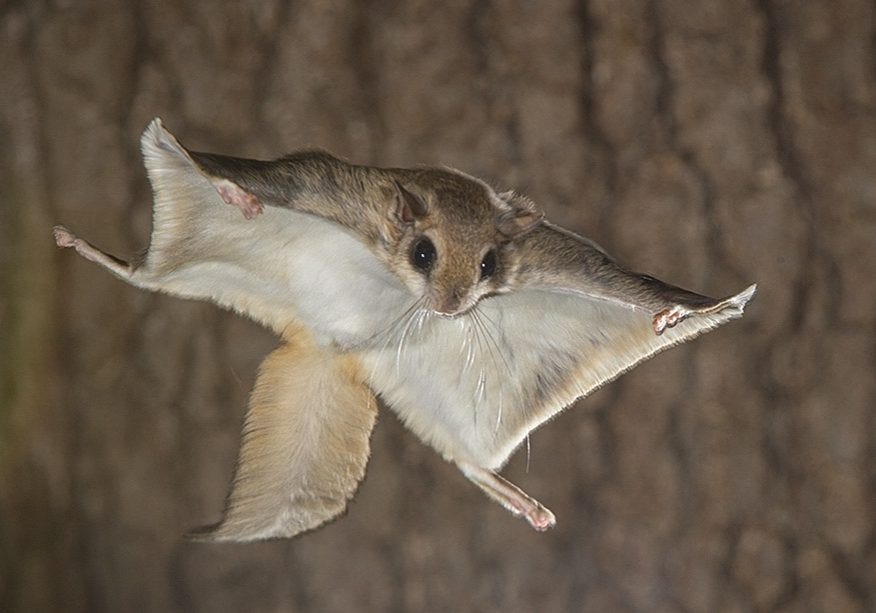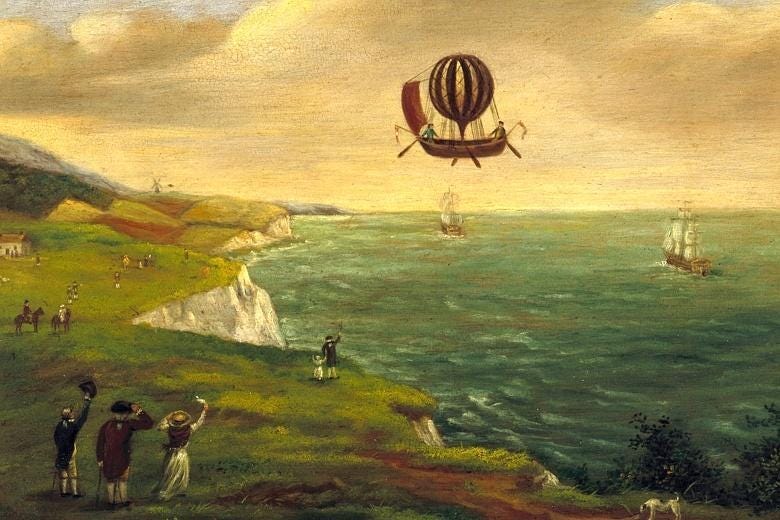Flights of Fancy
The dream of flying like birds has captivated human beings for thousands of years. In his new book, Richard Dawkins provides a fascinating account of the history of flight.
“It wasn’t luck that made them fly; it was hard work and common sense; they put their whole heart and soul and all their energy into an idea and they had the faith.”
– John T. Daniels on the Wright Brothers flight on December 17, 1903
There is no way to know exactly when human begins first started to look at the world around them and wonder why they could not fly like birds. I imagine that a hunter-gatherer might have thrown a stone at a bird, missed, and dreamed of being able to rise up into the air to pursue his prey. Humans have dreamt of flight ever since.1
Dreams of flight must have inspired the famous Greek story of Daedalus and Icarus. Imprisoned in a tower by King Minos, Daedalus constructs wings made of feathers, wax, and clothing. He and his son, Icarus, escape from the tower using these wings. Being a wise man, Daedalus warns his son not to use the wings to fly too close to the sea, where humidity might impair the loft of the feathers, or too close to the sun where heat would melt the wax. Arrogance and a youthful sense of invincibility leads Icarus to disregard his father’s advice. He flies too close to the sun. Tragedy ensues.
The legend of Icarus makes no sense to us today given that any grade school student knows that conditions get colder, not warmer, as we gain altitude. The ancient Greeks did not understand the Earth’s atmosphere and the way the greenhouse effect warms the planet’s surface. Jacob Peter Gowy, who painted The Fall of Icarus in the seventeenth century, made another mistake by depicting wings that are far too small to provide the surface area required to keep a human being aloft. Even with super-human strength, those tiny wings would have been totally inadequate.
Why are some animals capable of flight and how did they gain that ability? How did human beings finally conquer the skies? How did we go from the Wright Brothers achieving the first heavier-than-air flight in 1903 to Yuri Gagarin’s first manned spaceflight in 1961 to Neil Armstrong setting foot on the moon in 1969?
The Rational Walk is a reader-supported publication
To support my work and to receive all articles that I publish, including premium content, please consider a paid subscription. Thanks for reading!
Flights of Fancy: Defying Gravity by Design and Evolution is a fascinating new book by Richard Dawkins that answers many questions about the mechanics of what is required to fly, how evolution provided animals with that capacity, and how human beings have been able to conquer the skies despite have a physical anatomy that makes flight unaided by technology utterly impossible. The book’s message is enhanced by Jana Lenzová’s excellent illustrations which appear on nearly every page.
The book is part of a genre known as “popular science”, often looked down on by academics and those with a snobby disposition, but such books do a great service by making science accessible to everyone and serving as inspiration for those who might want to delve into more details elsewhere. I initially purchased this book as a gift for my teenage nephew but decided to buy a copy for myself after seeing the illustrations. This article describes a few interesting concepts from the book.
Surface Area is Key
Flight is much more difficult for larger creatures than for small ones. A tiny insect or a small bird might fly with relative ease, but the same is not true for larger birds and sheer size makes it inconceivable for a horse or elephant to take to the skies. Without using more than elementary mathematics, Dawkins explains how when an object is scales up, its volume and weight increases more steeply than its surface area.
“If you double the size of anything (say its length, with all other dimensions growing in proportion), you might think its volume and weight would double too. But it actually gets eight times heavier (2 x 2 x 2). This is true of any shape that you might scale up, including people, birds, bats, planes, insects and horses, but we can see it most clearly with square children’s bricks. Take one cubical brick. Now stack bricks to make the same shape but twice as big. How many bricks are there in the larger stack? Eight. The double-sized block of bricks weighs eight times as much as the single brick of the same shape. If you now make a stack three times as big, you’ll find you need twenty-seven bricks: 3 x 3 x 3, or 3-cubed. And if you try to build a stack measuring ten bricks in each direction, you’ll probably run out of bricks because 10-cubed (1,000) is an awful lot of bricks.”2
While the volume and weight of an object is cubed as it scales up in size, the surface area is only squared. As a result, the smaller you are, the larger your surface area will be relative to weight. As you grow, your surface area relative to your weight decreases. The reason smaller animals and objects find it easier to fly is because their surface area is greater relative to their weight.
Animals with a relatively large weight can still fly but they need to somehow develop a surface area that is large enough to compensate.
“... What if an animal needs to be large for some reason yet still needs to fly? It must compensate by increasing its surface area disproportionately: grow projections like feathers (if a bird) or flaps of thin skin (if a bat or a pterodactyl). However much material your body is made of (your volume or weight), if you splay some of that volume out into a big surface you will have taken a step toward flying. Or at least parachuting gently down, or floating in the breeze.” 3
Surface area is the key factor for aircraft as well as animals. Why did the Wright Brothers construct a plane that looked like this? It looks like it is all wing and not much else, doesn’t it?
Dawkins explains that early aircraft needed such a large surface area relative to its weight which is why biplanes were necessary. These were slow moving aircraft, and the faster a plane (or a bird) can fly, the more lift can be squeezed out of a given surface area. This is why early planes needed such a massive surface area relative to modern jets. While the wingspan of a 737 is hardly small, it is tiny relative to the weight of the plane when compared to the aircraft designed by the Wright brothers.
Unpowered Flight
Many animals are able to leverage a large surface area to glide through the air in surprising ways that are not so different from the way parachutes work. One of the more interesting cases is the “flying squirrel”. Almost all of us see squirrels on a daily basis given how well these small rodents seem to adapt to all sorts of environments. While natural acrobats, ordinary squirrels occasionally fall out of trees, often with fatal consequences. However, evolution has provided a solution for flying squirrels.
The surface area of this lucky squirrel is greatly enhanced by flaps of skins that extend out from its limbs. This does not allow for powered flight, since the squirrel cannot flap its “wings”, at least not with enough force to generate the lift needed to stay in the air. However, the flaps provide plenty of lift to safely glide from tree to tree. Dawkins discusses how these amazing creatures use this ability and notes that there are other animals such as the flying lemur that operate with the same concept.
There are some birds that have the capacity for powered flight, but prefer to conserve energy by launching from cliffs and gliding. And there are other methods to conserve effort. Dawkins describes how birds use an atmospheric feature called a thermal:
“A thermal is a vertical column of rising warm air surrounded by cooler air. Thermals commonly occur because the sun heats the ground unevenly. Some patches, for example rocky outcrops, get hotter than the surrounding land. This heats the air above the warm patch, which therefore rises as a thermal. Cold air comes in to replace it at the bottom of the thermal, is heated in turn, and rises. At the top of the thermal the air gets cold and descends round the sides of the thermal, circling down again to complete the convection cycle.” 4
Birds know how to identify thermals, which are often marked by fluffy cumulous clouds, and enter the thermal at the bottom. Then they spiral upward, potentially thousands of feet, with limited effort. At the top of the thermal, the bird exits and surveys its surroundings, identifying another thermal in the distance toward where it wishes to travel. The bird can then glide long distances aiming to enter the bottom of the next thermal to repeat the process. Apparently, human glider pilots apply the same principle that the birds have mastered instinctively.
Flying Across the English Channel … in 1785?
Following his fascinating discussion of unpowered flight, Dawkins goes on to describe the mechanics of powered flight and how animals have evolved to become masters of the air. This was all very interesting, but his chapter on lighter-than-air aircraft was mind blowing, at least for me.
The first human lighter-than-air flight took place in Paris in 1783, shortly before Thomas Jefferson began his five year residency in the city. I certainly had no idea that hot air balloons were developed that long ago. The Montgolfier brothers noticed that pockets of hot air pushed laundry toward the ceiling when drying over a fire. This gave them the idea of making hot air balloons which became progressively larger until experiments were conducted first with animals and then with human passengers.
Dawkins describes the first human flight in a hydrogen balloon:
“This flight was by Professor Jacques Charles, he after whom Charles’ law, governing the expansion of gases, is named. Charles rode in a beautiful boat-shaped car slung beneath his balloon. He landed a few miles outside Paris and was met by two dukes at a gallop. Not content with his maiden flight, Charles promptly took off again, having promised the Duke of Chartres that he would return. Which he did. Fortunately this hydrogen balloon didn’t catch fire, for that would have been goodbye balloon and goodbye intrepid aeronauts.” 5
When I picture eighteenth century France, I might think of Jefferson in Paris or the French Revolution, not hot air balloons carrying boat-shaped cars. But the story gets even crazier a couple of years later when Jean-Pierre Blanchard and John Jeffries crossed the English Channel in a hot air balloon, barely making it.
“With sufficient buoyancy to just lift the two aeronauts and their equipment, the Channel crossing was made at a very low altitude. During the flight, all ballast, their equipment and most of their clothing were jettisoned. They crossed the French coast at about 3:00 p.m. and at 3:30, came to rest in a clearing in the Felmores Forest, near Guînes.” 6
Conclusion
With his captivating writing style aided by great illustrations, Richard Dawkins has created a memorable book on flight that can be read in just a few hours and is sure to spark the curiosity of readers of all ages.
In addition to the examples covered in this article, Dawkins discusses evolutionary concepts regarding how animals gained the ability to fly and how some lost that ability over time. There is also a fascinating chapter about aerial plankton — tiny animals, plant matter, fungal spores, bacteria and viruses — that exist high in the atmosphere. A chapter on “Wings for Plants” explains how seeds are distributed over large areas and the mechanics of pollination. Finally, Dawkins discusses space travel and what the future might hold for Earth and human travel to Mars and beyond.
For those who are interested in reading this book, I would strongly recommend the hardcover physical book rather than Kindle. It is one of those books where the physical form factor is important for the full experience.
If you found this article interesting, please click on the ❤️️ button and consider sharing this issue with your friends and colleagues.
Thanks for reading!
Copyright and Disclaimer
This newsletter is not investment advice and all content is subject to the copyright and disclaimer policy of The Rational Walk LLC.
Your privacy is taken very seriously. No email addresses or any other subscriber information is ever sold or provided to third parties. If you choose to unsubscribe at any time, you will no longer receive any further communications of any kind.
The Rational Walk is a participant in the Amazon Services LLC Associates Program, an affiliate advertising program designed to provide a means for sites to earn advertising fees by advertising and linking to Amazon.com.
I recommend reading Yuval Noah Harari’s book, Sapiens: A Brief History of Humankind to better understand the development of Homo sapiens. I suspect that the ability to think in abstractions coincided with the development of fictive language.
Flights of Fancy, page 72-73
Ibid. p. 90-91
Ibid. p. 110-111
Ibid, p. 174






